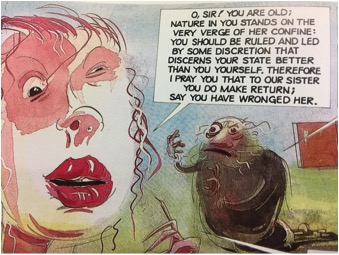By HLTD51 student FC
It is likely that many, if not most, people in North America will come across William Shakespeare in their lifetime. You may find yourself stumbling upon the famous Merchant of Venice quote “All that glitters is not gold” on stationery in your local bookstore, or discover the film you adore about star-crossed lovers with feuding families has been inspired by Romeo and Juliet. William Shakespeare was first introduced to me in high school through reading and analyzing the play “King Lear”. In my current experience as a University of Toronto Scarborough student minoring in health humanities, re-reading King Lear has been insightful in enhancing my understanding of the language of aging and the aging process overall.
Through Ian Pollock’s illustrated version of King Lear, the play that I’ve known and previously read has been illuminated with interesting looking characters and a macabre drawing style I have never seen. It provides the reader with visual context and enables for a different reading experience then just the straightforward and classic Shakespearian text. Throughout the illustrated King Lear, the reader is constantly interacting with an experience aging through the visual use of language and image, from Regan and Goneril to King Lear himself.
*
Throughout the play, the audience takes a journey through King Lear’s experience of aging. In the beginning of the play, he announces that he would like to finally retire and divide his kingdom between his three daughters (Cordelia, Goneril and Regan) through a test of love. He casts away his most beloved daughter Cordelia and gives all his land to his remaining daughters. The audience finds themselves watching as each daughter devalues and delegitimizes Lear’s authority and selfhood as ruler of the kingdom through the language of aging.
In Kathleen Woodward’s Introduction to the collection Figuring Age: Women, Bodies, Generations (1999), Woodward begins with Anna Gerbner’s story of “death by invisibility”. In this narrative, an older (86-year-old) woman is run over by a young man who “just didn’t see her”; Woodward argues that Gerbner’s death nevertheless generates an activist space or an “arena of visibility” for older age (Woodward, 1999). With these ideas in mind, I suggest in the play King Lear, Goneril and Regan attempt to kill Lear through death by invisibility with allowing him enter the storm while blatantly closing their castle doors in Act II, Scene VI (page 64 in Pollock’s book). Although the daughters clearly recognize the dangers their father would encounter outside the castle walls, they did not invite him in and encouraged those around them that their ideas were valid.
Woodward also introduces the term “pedagogy of mortification” in which she suggests that individuals teach an older individual to recede into their invisibility (Woodward, 1999). This is clearly visible in King Lear through how the daughters treat their father and literally strip him of his selfhood and identity as king. It begins in Act I, Scene IV where Goneril casts away half of his servants and knights. He asked specifically that when retiring, he would have 100 knights, servants and a jester to keep him entertained while his daughters would take care of the kingdom. By ignoring his request to keep his servants, Goneril slowly chips away at Lear’s identity as king and enacts the pedagogy of mortification:
O, sir, you are old.
Nature in you stands on the very verge
Of her confine: you should be ruled and led
By some discretion, that discerns your state
Better than you yourself. Therefore, I pray you,
That to our sister you do make return;
Say you have wrong’d her, sir.
Angered, he goes to his other daughter Regan and similar things happen where she disrespects her father. In Act IV, Scene VII, the audience can see King Lear embodied this language and narrative of aging and decline that his daughters have instilled in him when he says “I am a very foolish fond old man, / Fourscore and upward, not an hour more or less; / And, to deal plainly, / I fear I am not in my perfect mind”.
*
Although it may seem that King Lear’s narrative is bleak and presents an overall negative portrait of the aging process, I suggest that Shakespeare’s work is a way in which we as an audience can think about how we treat the aging population. I suggest King Lear creates an arena of visibility for elderly individuals. It enables discussion through literary forms (i.e. character development, themes and motifs) centuries after its conception. The audience engages with King Lear’s character and his aging experience through his personal narrative. This theatrical performance reminds the audience that the essence of personhood can be stripped away through the language of aging and through the “pedagogy of mortification” (Woodward, 1999). It signals us to be cognizant of the treatment of others and encourages us to think deeply about the personal experiences faced through the aging process.

